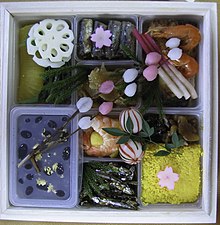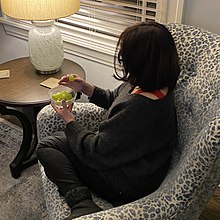New Year's food
[1]: 13 The rituals of the extended festival surrounding January 1, including the traditional foods and hospitality required, served to build community.
[12] Rosh Hashanah meals usually include apples dipped in honey to symbolize a sweet new year; this is a late medieval Ashkenazi addition, though it is now almost universally accepted.
[18] Some of the symbolic foods eaten are dates, black-eyed peas, leeks, spinach, and gourd, all of which are mentioned in the Talmud:[19] "Let a man be accustomed to eat on New Year's Day gourds (קרא), and fenugreek (רוביא),[20] leeks (כרתי), beet [leaves] (סילקא), and dates (תמרי)."
[7]: 3 The Persian calendar New Year, No Ruz, is a two-week period celebrated at the vernal equinox which includes playing Buzkashi, considered Afghanistan's national sport, and eating samanak and haft mewah or haft mewa, which translates to "7 fruits" and is a dish of 7 dried fruits and nuts typically including raisins and golden raisins, dried apricots, senjed, walnuts, almonds, and pistachios, although recipes vary by region and family.
[citation needed] New Year's foods may also include sabzi chalaw, a type of spinach and lamb curry; maasteh khanagi, a type of yogurt; kolcheh nowrozi or kulchai nowrozi, a cookie; and mahee and jelabi or mahi wa jelabi, a deep-fried fish accompanied by a fried and sugar-glazed batter.
[7]: 3–4 No Ruz is celebrated on January 1 and includes haft sin, seven items that begin with the Persian letter sin, or S, typically including the food items samanu, sabzeh, seer, senjed, and serkeh, along with sekeh, a gold coin symbolizing prosperity, and sonbol, a flower symbolizing life and beauty.
[7]: 12 Samani, pakhlava and shakarbura are commonly eaten in the north and yeddi lovun, a type of haft sin, in the south.
Unmarried family members take the first bite of the banitza and place it beneath their pillow to dream of their future spouse.
The groups sing songs wishing a new year filled with food bounty for all and are given gifts of bread, fruits, and walnuts.
Gifts of citrus such as tangerines, oranges, and pomelos are thought to represent prosperity and are auspicious for New Year's Eve; their shape, color, and names are seen as symbolizing fullness and wealth.
[2][28] Other commonly served dishes are spring rolls, dumplings, longevity noodles, glutinous rice cake or nian gao, the name of which means progressively improving.
On the 15th day the Lantern Festival is celebrated, also called Yuan Xiao, a name for glutinous rice balls which are eaten and symbolize unity, family, and peace.
[29] Traditional celebration food on New Year's Eve is virsli, a sausage served with mustard or horseradish, and a poppyseed roll known as bejgli.
Haft sin is prepared from seven items, primarily foods, to symbolize good fortune in the new year; these typically include sabzeh (sprouted grains or legumes) for rebirth, sangak for prosperity, senjed for love, seeb for health and beauty, samanu for fertility, somaq for good triumphing over evil, seer for medicine, sohan for the "sweetness of life", and serkeh (an aged vinegar) for patience and age.
[7]: 122–123 Lentils, the most common of which are greenish-brown disks, are considered to resemble the coins of ancient Rome and are symbolic of good luck and prosperity.
Most families will serve kozheh, a dish that includes seven ingredients symbolizing life and rebirth: water, meat, salt, flour, fat, a grain such as corn, rice, or wheat, and milk.
[7]: 133–134 In some areas it is common for a woman to serve qyaqi ashar, a horse meat dish, to her boyfriend on New Year's Eve.
[7]: 155 Tamales are a traditional food in Mexico throughout the holiday season from the Feast of Our Lady of Guadalupe on 12 December to Three Kings' Day on 6 January.
[33][34] Oliebollen, a type of deep-fried sweetened dumpling, is a traditional New Year's Eve snack sold from temporary kiosks called Oliebollenkramen.
[11] It is considered good luck in Spain to eat twelve grapes at midnight, one at each tolling of the bell in the Real Casa de Correos clocktower at Puerta del Sol in Madrid, while wearing red underwear received as a gift.
[35] The custom is called las doce uvas de la suerte, which means "the twelve lucky grapes.
"[3] Superstition says that on Nochevieja or "old night", failing to keep up with the clocktower will result in unlucky months; to ensure they can keep up with the tolling of the bell, some prepare their grapes ahead of time for faster consumption by peeling and seeding them.
[39] Typically the grapes used are a greenish-white variety called Aledo which are a traditional Spanish product that ripens in November or December and has denominación de origen status.
[30][3] The fact that pigs root forward (as opposed to chickens, which scratch backward) is considered to be symbolic of making progress in the future.
[30] The traditional butchering calendar also meant fresh pork was available at the time,[3] and in most of the lower midwest cabbage is a late-year product.
"[6][30] The tradition of eating Hoppin' John originated with enslaved people and dates to at least the 19th century; the first known mention is in the 1838 novel Recollections of a Southern Matron.
[3][49] King cakes in the shape of a ring also are traditionally part of celebrations in the first days of the new year in the southern US, often with trinkets and coins baked inside.
[3][50] In areas with a large number of descendants of Italian immigrants, dishes of lentils and sausages are common New Year foods.
[30] A related tradition is the smashing and sharing of peppermint pigs on Christmas Day to ensure good luck in the new year.
A common dish is sticky rice cakes baked in banana leaves and served in sugar cane syrup.





